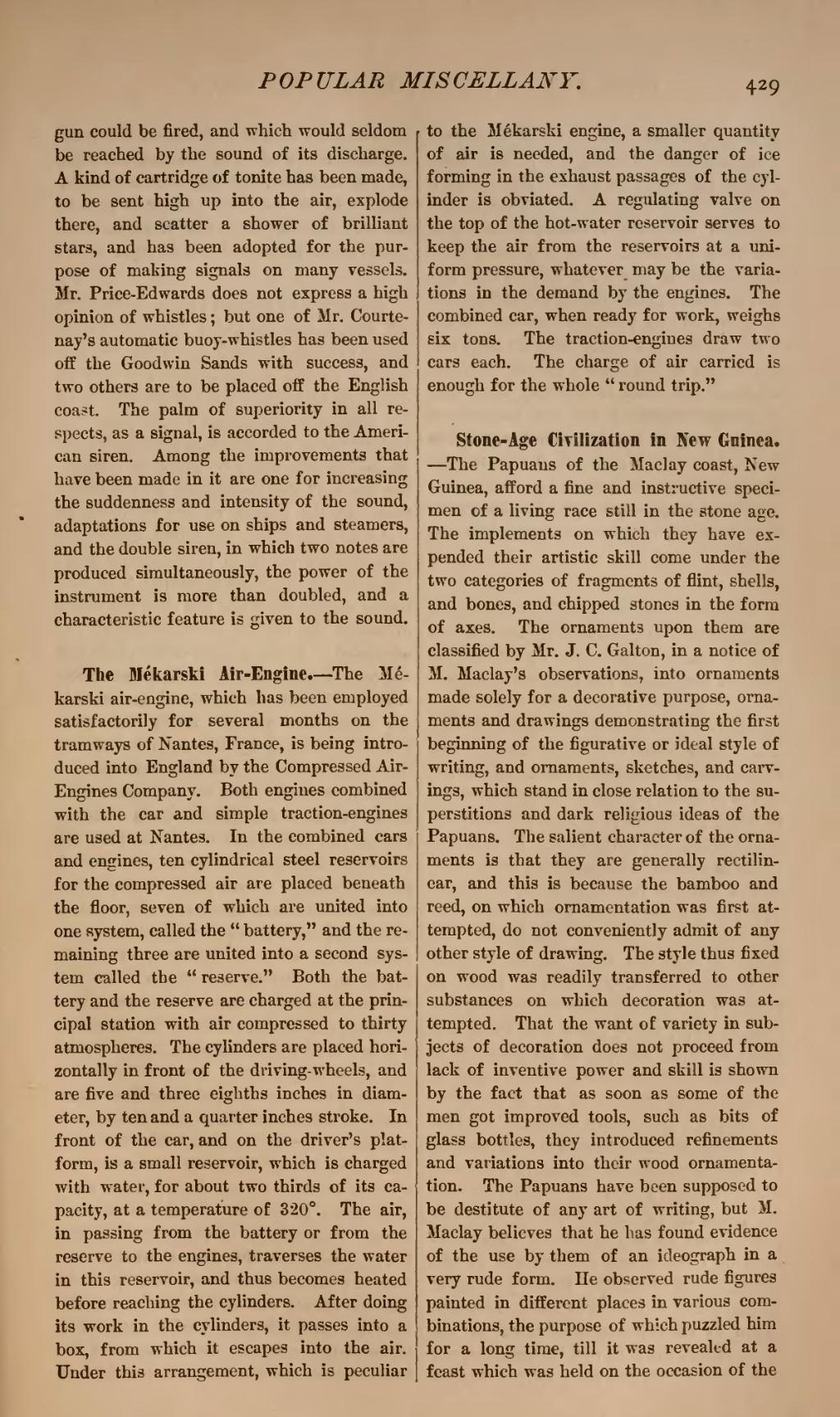gun could be fired, and which would seldom be reached by the sound of its discharge. A kind of cartridge of tonite has been made, to be sent high up into the air, explode there, and scatter a shower of brilliant stars, and has been adopted for the purpose of making signals on many vessels. Mr. Price-Edwards does not express a high opinion of whistles; but one of Mr. Courtenay's automatic buoy-whistles has been used off the Goodwin Sands with success, and two others are to be placed off the English coast. The palm of superiority in all respects, as a signal, is accorded to the American siren. Among the improvements that have been made in it are one for increasing the suddenness and intensity of the sound, adaptations for use on ships and steamers, and the double siren, in which two notes are produced simultaneously, the power of the instrument is more than doubled, and a characteristic feature is given to the sound.
The Mékarski Air-Engine.—The Mékarski air-engine, which has been employed satisfactorily for several months on the tramways of Nantes, France, is being introduced into England by the Compressed Air Engines Company. Both engines combined with the car and simple traction-engines are used at Nantes. In the combined cars and engines, ten cylindrical steel reservoirs for the compressed air are placed beneath the floor, seven of which are united into one system, called the "battery," and the remaining three are united into a second system called the "reserve." Both the battery and the reserve are charged at the principal station with air compressed to thirty atmospheres. The cylinders are placed horizontally in front of the driving-wheels, and are five and three eighths inches in diameter, by ten and a quarter inches stroke. In front of the car, and on the driver's platform, is a small reservoir, which is charged with water, for about two thirds of its capacity, at a temperature of 320°. The air, in passing from the battery or from the reserve to the engines, traverses the water in this reservoir, and thus becomes heated before reaching the cylinders. After doing its work in the cylinders, it passes into a box, from which it escapes into the air. Under this arrangement, which is peculiar to the Mékarski engine, a smaller quantity of air is needed, and the danger of ice forming in the exhaust passages of the cylinder is obviated. A regulating valve on the top of the hot-water reservoir serves to keep the air from the reservoirs at a uniform pressure, whatever may be the variations in the demand by the engines. The combined car, when ready for work, weighs six tons. The traction-engines draw two cars each. The charge of air carried is enough for the whole "round trip."
Stone-Age Civilization in New Guinea.—The Papuans of the Maclay coast, New Guinea, afford a fine and instructive specimen of a living race still in the stone age. The implements on which they have expended their artistic skill come under the two categories of fragments of flint, shells, and bones, and chipped stones in the form of axes. The ornaments upon them are classified by Mr. J. C. Galton, in a notice of M. Maclay's observations, into ornaments made solely for a decorative purpose, ornaments and drawings demonstrating the first beginning of the figurative or ideal style of writing, and ornaments, sketches, and carvings, which stand in close relation to the superstitions and dark religious ideas of the Papuans. The salient character of the ornaments is that they are generally rectilinear, and this is because the bamboo and reed, on which ornamentation was first attempted, do not conveniently admit of any other style of drawing. The style thus fixed on wood was readily transferred to other substances on which decoration was attempted. That the want of variety in subjects of decoration does not proceed from lack of inventive power and skill is shown by the fact that as soon as some of the men got improved tools, such as bits of glass bottles, they introduced refinements and variations into their wood ornamentation. The Papuans have been supposed to be destitute of any art of writing, but M. Maclay believes that he has found evidence of the use by them of an ideograph in a very rude form. He observed rude figures painted in different places in various combinations, the purpose of which puzzled him for a long time, till it was revealed at a feast which was held on the occasion of the
